Did you know that grey is not actually a true color in horses? It’s a gene mutation that causes a process of hair depigmentation. Since I regularly field questions about grey horses and why they dapple out and eventually turn white, I’ve laid out a series of photos I snapped from around North America over the last decade. The photos help illustrate this enjoyable stroll through some very simplified equine color genetics of Percheron horses.
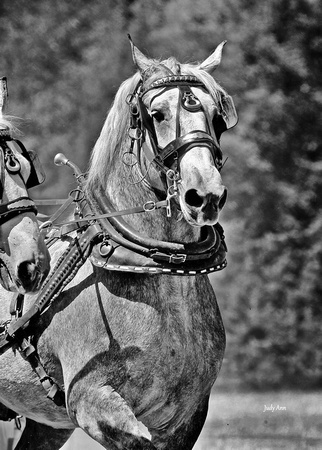 GarthHandsome Garth, left lead of the Valley View Percheron hitch, Custer, Washington
GarthHandsome Garth, left lead of the Valley View Percheron hitch, Custer, Washington
(Above) This handsome fellow is about five years old and has turned from his birth color of black to a rich dapple grey.
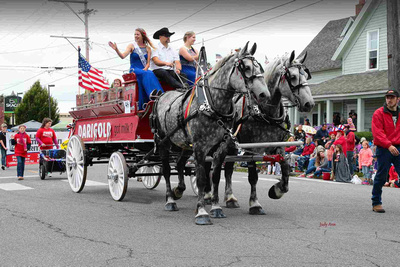 Dapple grey Percheron horsesPatrick Wilder of Valley View Percherons
Dapple grey Percheron horsesPatrick Wilder of Valley View Percherons
Depigmentation is well underway on this pair who were also born black. Farmers Day Parade in Lynden, Washington.
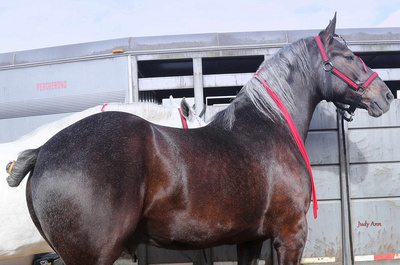 Phantom A four-year old gelding has not yet greyed out. Valley View Percherons
Phantom A four-year old gelding has not yet greyed out. Valley View Percherons
The beautiful dapple-grey Percherons of the Valley View hitch are born very dark, almost black. This is four-year-old Phantom. His mane and tail are grey, as are parts of his face. His dark coat is beginning to lighten and is already sporting some gorgeous dapples.
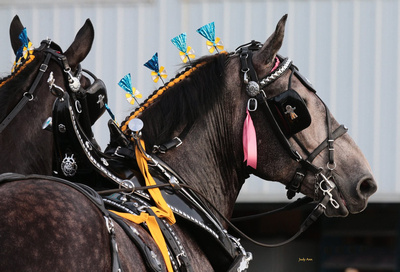 MelodyHidden View Melody of Blue Ribbon Days is a rich dapple grey in her younger years.
MelodyHidden View Melody of Blue Ribbon Days is a rich dapple grey in her younger years. Hidden View Melody of the Blue Ribbon Days hitch is seen here a few years back when she was a dark, dapple grey.
Hidden View Melody of the Blue Ribbon Days hitch is seen here a few years back when she was a dark, dapple grey.
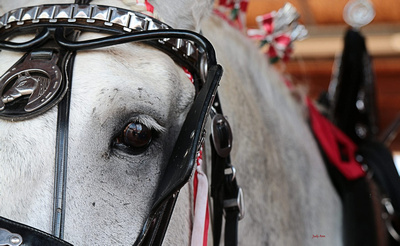 Percheron gelding, CashValley View Percherons, Custer, Washington at the Washington State Fair in Puyallup
Percheron gelding, CashValley View Percherons, Custer, Washington at the Washington State Fair in Puyallup
They lighten as they age, and every horse is different; some are completely white by the time they’re six to eight years old.
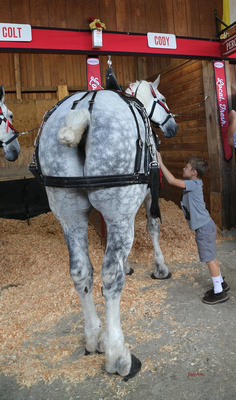 Cody and LucasDapple grey Percheron at the Washington State Fair
Cody and LucasDapple grey Percheron at the Washington State Fair
Some horses are slower to turn white, maintaining their grey dapples even until ten to twelve years of age. Cody was twelve years old in this image and still covered beautiful grey dapples.
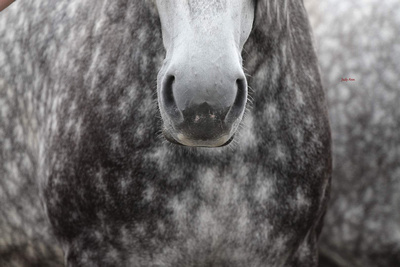 Percheron HorsesJudy Ann Photo of Sedro Woolley captures this dapple grey Percheron in Custer, Washington.
Percheron HorsesJudy Ann Photo of Sedro Woolley captures this dapple grey Percheron in Custer, Washington. 
In laymen’s terms, grey is the result of a mutation that causes the hair shaft to lose pigmentation over time, eventually losing all color. The gene variants responsible are known as alleles. Just like in humans, there are dominant alleles (genes) and recessive alleles; with eye color, brown is dominant to blue; therefore, a child born with a blue allele from mom and a brown allele from dad will end up with brown eyes. (Remember, we're talking about the genetic code, not the color of the parents' eyes.)
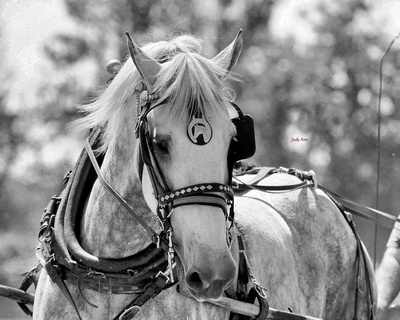 Dapple greyCurt Wilder of Valley View Percherons, Custer, Washington driving one of the family's geldings.
Dapple greyCurt Wilder of Valley View Percherons, Custer, Washington driving one of the family's geldings. With horses, the grey allele is dominant. If a grey horse is homozygous, meaning that it has a grey allele from both parents, it will always produce grey offspring no matter the color genetics of the horse it is mated to. Above is a Valley View Percheron at about six years of age.
With horses, the grey allele is dominant. If a grey horse is homozygous, meaning that it has a grey allele from both parents, it will always produce grey offspring no matter the color genetics of the horse it is mated to. Above is a Valley View Percheron at about six years of age.
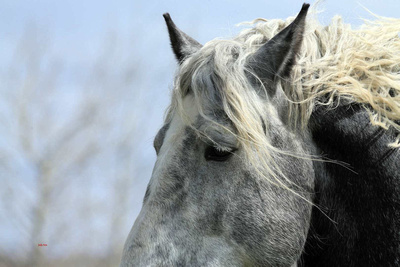 Eaglesfield PercheronsBrigadier owned by Brian & Colleen Coleman, Alberta.
Eaglesfield PercheronsBrigadier owned by Brian & Colleen Coleman, Alberta.
A horse carrying one copy of the grey allele regardless of other color genes present will always become grey, and this means that all grey horses must have at least one grey parent. That also means that it’s impossible for a horse to carry a recessive grey gene: because all grey horses have at least one grey parent and since grey is dominant over other colors, that horse will always turn grey. Percheron stallion, Eaglesfield Brigadier, Alberta, Canada.
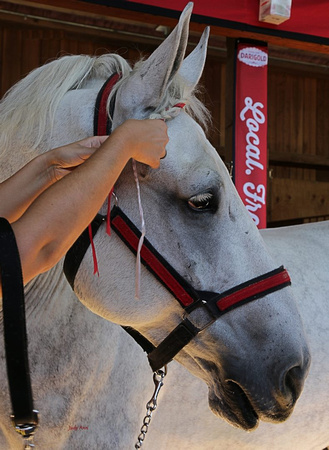 CodyWashington State Fair Draft Horse Show; Valley View Percherons
CodyWashington State Fair Draft Horse Show; Valley View Percherons
Another question that arises is, what is the difference between a white horse and a grey horse when the hair coat is completely white? The grey allele does not affect skin color, and here’s your answer: look at the “points” of the horse, much like you would a Siamese cat. His eyes and other skin areas where hair is sparse such as around his muzzle and his the tail will be very dark. A "white" horse has unpigmented pink skin which is evident at birth.
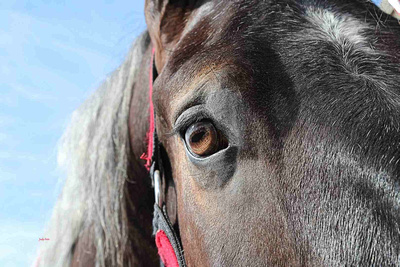 PhantomValley View Percherons, photo by Judy Ann Photo of Sedro Woolley
PhantomValley View Percherons, photo by Judy Ann Photo of Sedro Woolley Phantom’s pigment will always be dark even as his hair becomes depigmented.
Phantom’s pigment will always be dark even as his hair becomes depigmented.
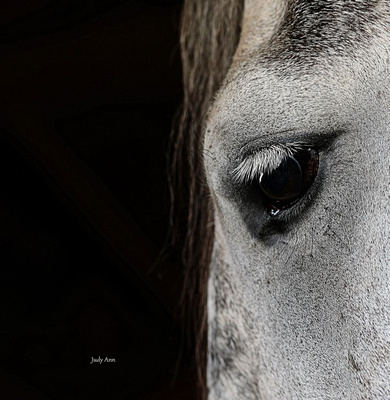 Beautiful Percheron geldingPhoto by Judy Ann Photo of Sedro Woolley, WA of Valley View Percherons
Beautiful Percheron geldingPhoto by Judy Ann Photo of Sedro Woolley, WA of Valley View Percherons Unlike the hairs, the grey gene does not cause depigmentation of the skin or eyes. So grey horses will almost always have dark skin and dark eyes. Though he is getting lighter over the years and will eventually be completely white, Cash still has his dark eyes and dark pigment around those eyes.
Unlike the hairs, the grey gene does not cause depigmentation of the skin or eyes. So grey horses will almost always have dark skin and dark eyes. Though he is getting lighter over the years and will eventually be completely white, Cash still has his dark eyes and dark pigment around those eyes.
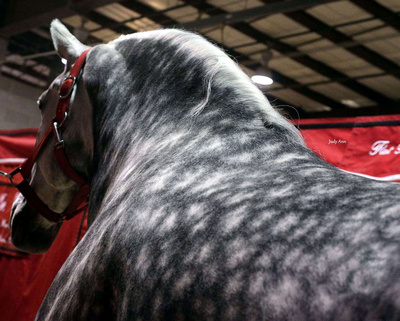 Dapple greyGrey Percherons carry the dominant grey allele. It's a depigmentation of the hair that causes the lovely dapples of these horses.
Dapple greyGrey Percherons carry the dominant grey allele. It's a depigmentation of the hair that causes the lovely dapples of these horses.
That means if you shaved a dapple-grey horse, the skin beneath that hair coat would not be dappled.
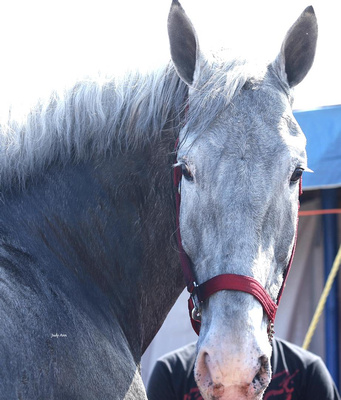 Vitiligo in grey horsesDominant alleles in equine color. Dapple grey Percheron from Ames Percherons, Jordan, Minnesota.
Vitiligo in grey horsesDominant alleles in equine color. Dapple grey Percheron from Ames Percherons, Jordan, Minnesota. There is one rare exception in that some grey horses can go through a progressive depigmentation in the skin, called vitiligo. This results in pink-colored patches around the eyes, muzzle, and under the tail.
There is one rare exception in that some grey horses can go through a progressive depigmentation in the skin, called vitiligo. This results in pink-colored patches around the eyes, muzzle, and under the tail.
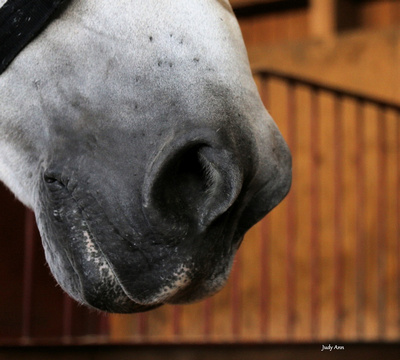 Grey color in Percheron horsesVitiligo on muzzle of a dapple grey Percheron. Photo by Judy Ann Photo of Washington State
Grey color in Percheron horsesVitiligo on muzzle of a dapple grey Percheron. Photo by Judy Ann Photo of Washington State
Signs of vitiligo beginning on the muzzle.
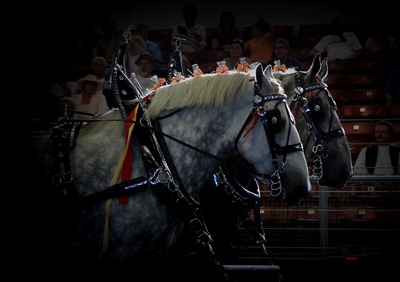 Dominant allele in grey horsesA pair of grey Percheron geldings owned by Valley View of Custer, Washington. Photo by Judy Ann Photo of Sedro Woolley, Washington
Dominant allele in grey horsesA pair of grey Percheron geldings owned by Valley View of Custer, Washington. Photo by Judy Ann Photo of Sedro Woolley, Washington
One more note. If a grey horse carries one copy of the grey allele and is mated with a non-grey carrying horse, there is still a 50% chance of grey offspring.
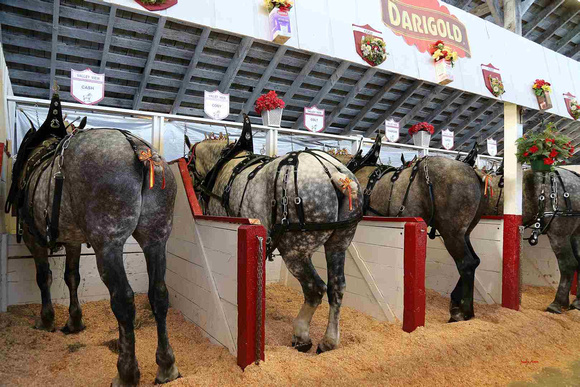 Dapple grey PercheronsJudy Ann Photo of Skagit Valley; from the Valley View hitch performing in Puyallup
Dapple grey PercheronsJudy Ann Photo of Skagit Valley; from the Valley View hitch performing in Puyallup
The next time someone mentions a grey horse? You can politely educate them that grey is not actually a color, it's a process of depigmentation. No butts about it.